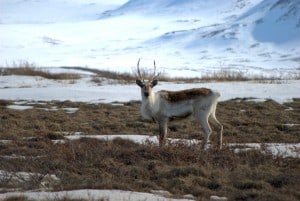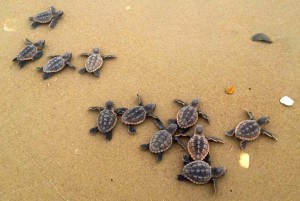Share this article
Species feeling the heat from climate change: Part 1
USGS is providing a two-part series on eight species feeling the effects of climate change. Part 2 will be available next week.
From forest to grassland, desert to ocean, many wildlife species are already “feeling the heat” from climate change. Scientists, supported by the eight regional Department of the Interior Climate Science Centers (CSCs) (which are managed by the USGS National Climate Change and Wildlife Science Center), are actively striving to learn more about what climate change effects on wildlife will look like, whether or not species will be able to adapt and survive, and what natural resource managers can do to help. Here are eight animals that provide a glimpse into how climate change is impacting wildlife across the country.
Caribou

©USGS
As temperatures increase there will likely be more big fire years in Alaska, and this is expected to considerably change caribou habitat. For example, wildfire can destroy slow growing lichens in black spruce forests – a highly nutritious and important winter food source for caribou. Loss of winter habitat for caribou caused by fires in spruce forests could also ultimately affect subsistence hunters who rely on caribou for nutritional, cultural and economic reasons. Learn more about our research.
Loggerhead Sea Turtle

©USGS
Atlantic sea turtles such as the threatened loggerhead are especially vulnerable to coastal climate change impacts. Loggerhead sea turtles spend most of their lives in the ocean, but every couple of years, females come ashore about four or five times per nesting season to lay eggs. These turtles rely on a large area of the southeastern U.S. coastline and have been found to travel as far as 250 miles from one nest to the next! Coastal climate change impacts like rising sea levels, increasing storm frequency, and changing temperature and humidity threaten to eliminate or impair the beaches that loggerheads use for nesting. Learn more about our research.
Snowshoe Hare
Snowshoe hares have evolved the ability to change fur color during different seasons (white in the presence of snow and brown in warmer seasons) in order to camouflage with their surroundings and hide from predators, like lynx and bobcats. Climate change, however, is causing snow in many areas to melt earlier than the hares have grown accustomed to, leaving stark white hares exposed in non-white, snow-less landscapes. Hares are critical players in forest ecosystems, because they are an important prey source for many carnivore species. This increased exposure and vulnerability could cause such high mortality rates that hare populations could rapidly decline, ultimately affecting the entire forest ecosystem. Learn more about our research.
Atlantic Salmon
Atlantic salmon spend most of their adult lives in the sea, but return to the cool freshwater streams of Maine to breed and lay eggs. Northeastern Atlantic salmon are already endangered, and climate change may further threaten their survival. In particular, warming water temperatures and changing patterns of streamflow are problematic for Atlantic salmon. Such changes may reduce the amount of habitat suitable for nesting, decrease the number of eggs that survive, and disrupt the growth and development of young. Learn more about our research.
Learn more by exploring our project pages by region or searching for a specific topic or animal!
Header Image: ©USGS








